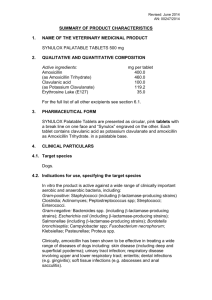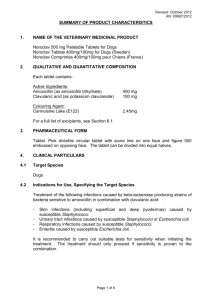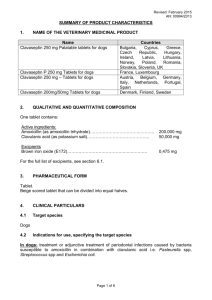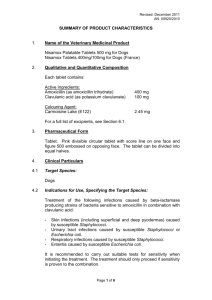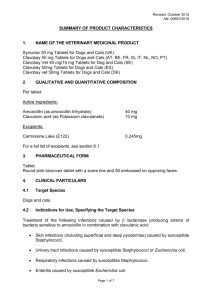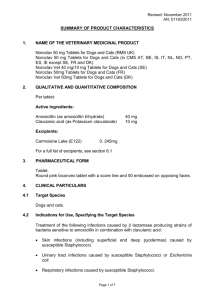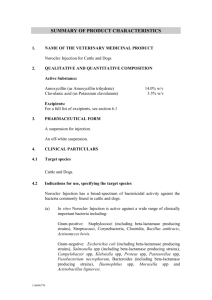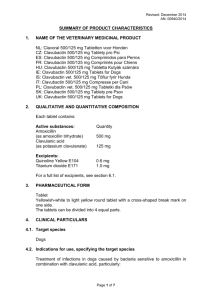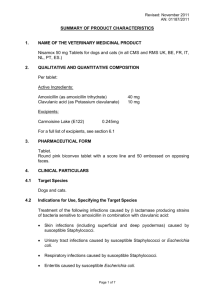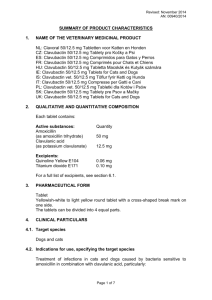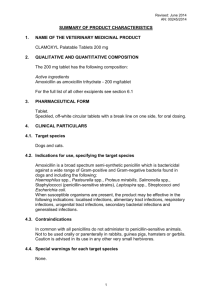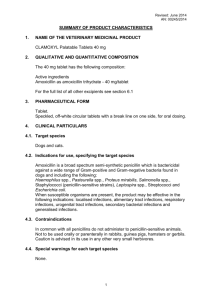Revised: February 2015 AN: 00994/2013 SUMMARY OF PRODUCT
advertisement
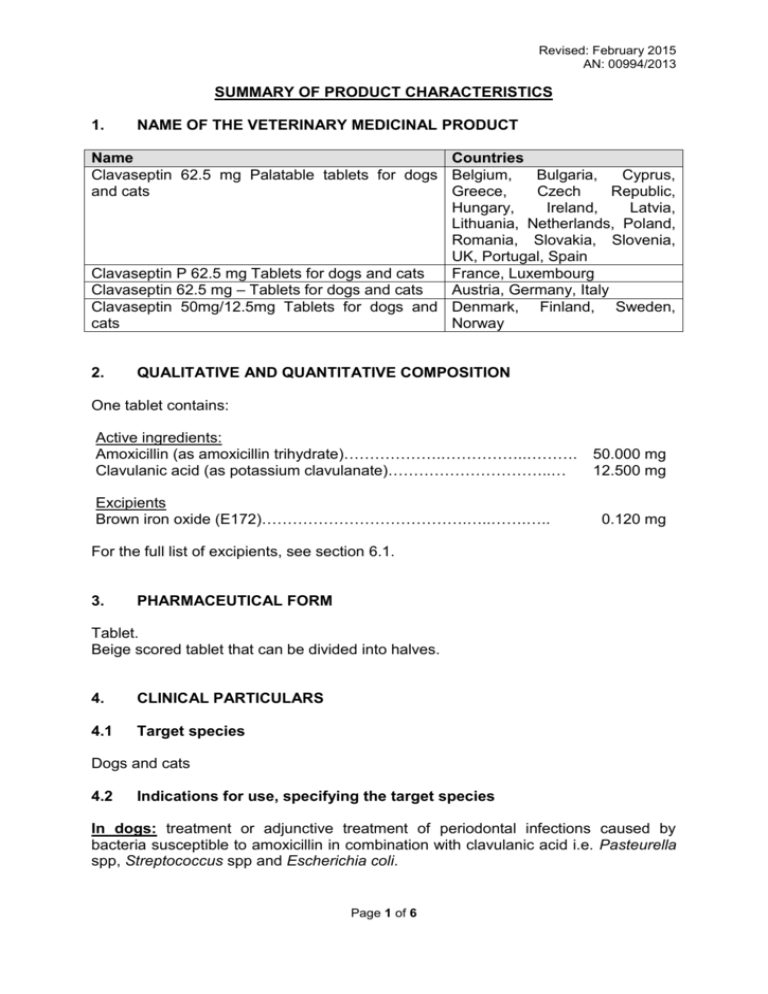
Revised: February 2015 AN: 00994/2013 SUMMARY OF PRODUCT CHARACTERISTICS 1. NAME OF THE VETERINARY MEDICINAL PRODUCT Name Countries Clavaseptin 62.5 mg Palatable tablets for dogs Belgium, Bulgaria, Cyprus, and cats Greece, Czech Republic, Hungary, Ireland, Latvia, Lithuania, Netherlands, Poland, Romania, Slovakia, Slovenia, UK, Portugal, Spain Clavaseptin P 62.5 mg Tablets for dogs and cats France, Luxembourg Clavaseptin 62.5 mg – Tablets for dogs and cats Austria, Germany, Italy Clavaseptin 50mg/12.5mg Tablets for dogs and Denmark, Finland, Sweden, cats Norway 2. QUALITATIVE AND QUANTITATIVE COMPOSITION One tablet contains: Active ingredients: Amoxicillin (as amoxicillin trihydrate)……………….……………..………. Clavulanic acid (as potassium clavulanate)…………………………..… Excipients Brown iron oxide (E172)………………………………….…..…….….. 50.000 mg 12.500 mg 0.120 mg For the full list of excipients, see section 6.1. 3. PHARMACEUTICAL FORM Tablet. Beige scored tablet that can be divided into halves. 4. CLINICAL PARTICULARS 4.1 Target species Dogs and cats 4.2 Indications for use, specifying the target species In dogs: treatment or adjunctive treatment of periodontal infections caused by bacteria susceptible to amoxicillin in combination with clavulanic acid i.e. Pasteurella spp, Streptococcus spp and Escherichia coli. Page 1 of 6 Revised: February 2015 AN: 00994/2013 In cats: treatment of skin infections (including wounds and abscesses) caused by bacteria susceptible to amoxicillin in combination with clavulanic acid i.e. Pasteurella spp, Staphylococcus spp, Streptococcus spp and Escherichia coli. 4.3 Contraindications Do not use in animals with known hypersensitivity to penicillins or other substances of the β-lactam group. Do not administer to gerbils, guinea pigs, hamsters, rabbits and chinchillas. 4.4 Special warnings for each target species None 4.5 Special precautions for use Special precautions for use in animals In addition to section 4.3 contraindications: In animals with impaired liver and kidney function, the use of the product should be subject to a risk/benefit evaluation by the veterinary surgeon and the posology evaluated carefully. Caution is advised in the use in small herbivores other than those in 4.3. Use of the product should be based on susceptibility testing. Inappropriate use of the product may increase the prevalence of bacteria resistant to amoxicillin/clavulanic acid. Use of the product should take into account official and local antimicrobial policies. Special precautions to be taken by the person administering the veterinary medicinal product to animals Penicillins and cephalosporins may cause hypersensitivity (allergy) following injection, inhalation, ingestion or skin contact. Hypersensitivity to penicillins may lead to cross reactions to cephalosporins and vice versa. Allergic reactions to these substances may occasionally be serious. 1. Do not handle this product if you know you are sensitised, or if you have been advised not to work with such preparations. 2. Handle this product with great care to avoid exposure, taking all recommended precautions. 3. If you develop symptoms following exposure, such as skin rash, you should seek medical advice and show the doctor this warning. Swelling of the face, lips or eyes or difficulty breathing are more serious symptoms and require urgent medical attention. Wash hands after handling the tablets. Page 2 of 6 Revised: February 2015 AN: 00994/2013 4.6 Adverse reactions (frequency and seriousness) Vomiting and diarrhoea may be observed. Treatment may be discontinued depending on the severity of the undesirable effects and a benefit/risk evaluation by the veterinary surgeon. Hypersensitivity reactions (allergic skin reactions, anaphylaxis) may be observed. In these cases, administration should be discontinued and a symptomatic treatment given. 4.7 Use during pregnancy, lactation or lay The safety of the product has not been established during pregnancy and lactation. Laboratory studies in rats have not produced any evidence of teratogenic, foetotoxic or maternotoxic effects. Use the product only accordingly to the benefit/risk assessment by the responsible veterinarian. 4.8 Interaction with other medicinal products and other forms of interaction The bactericidal activity of amoxicillin may be reduced by the simultaneous use of bacteriostatic substances such as macrolides, tetracyclines, sulfonamides and chloramphenicol. 4.9 Amounts to be administered and administration route The recommended dose of the product is 10 mg amoxicillin /2.5 mg clavulanic acid per kg body weight twice a day by the oral route in dogs and cats, i.e. 1 tablet per 5 kg body weight every 12 h, according to the following table: Bodyweight (kg) [ 1.0- 2.5 ] [ 2.6- 5.0 ] [ 5.1- 7.5 ] [ 7.6- 10.0 ] Number of tablets twice daily ½ 1 1½ 2 In severe infections, the dose may be doubled to 20 mg amoxicillin / 5 mg clavulanic acid/kg body weight twice daily. Duration of treatment: - 7 days for the treatment of periodontal infections in dogs. - 7 days for the treatment of skin infections in cats (including wounds and abscesses). The clinical status of animals should be re-evaluated after 7 days and the treatment prolonged for a further 7 days if necessary. Severe cases of skin infection may require an even longer duration of treatment and this should be at the discretion of the responsible veterinarian. To ensure the correct dosage, body weight should be determined as accurately as possible to avoid under-dosing. Page 3 of 6 Revised: February 2015 AN: 00994/2013 4.10 Overdose (symptoms, emergency procedures, antidotes), if necessary At three times the recommended dose for a period of 28 days, a decrease in cholesterol values and episodes of vomiting were observed in cats and diarrhoea was observed in dogs. In the event of an overdose symptomatic treatment is advised. 4.11 Withdrawal period(s) Not applicable 5. PHARMACOLOGICAL PROPERTIES Pharmacotherapeutic group: anti-infective for systemic use; amoxicillin and enzyme inhibitor. ATCvet code: QJ01CR02 5.1 Pharmacodynamic properties Amoxicillin is an aminobenzylpenicillin from the β-lactam penicillin family which prevents the bacterial cell wall formation by interfering with the final step of peptidoglycan synthesis. Clavulanic acid is an irreversible inhibitor of intracellular and extracellular βlactamases which protects amoxicillin from inactivation by many β-lactamases. Amoxicillin/clavulanate has a wide range of activity which includes β-lactamase producing strains of both Gram-positive and Gram-negative aerobes, facultative anaerobes and obligate anaerobes. Amoxicillin/clavulanic acid breakpoints (NCCLS/2002): Staphylococci: sensitive: MIC < 4/2 µg/ml, resistant: MIC > 8/4 µg/ml Other organisms: sensitive: MIC < 8/4 µg/ml, resistant: MIC > 32/16 µg/ml In dog periodontal infections in Europe (isolates of the year 2002 from France, Germany and Belgium) amoxicillin/clavulanic acid combination in a ratio 2/1 showed the following data on sensitivity: Streptococcus spp.: MIC90: 0.4/0.2 µg/ml, Pasteurellaceae: MIC90: 0.4/0.2 µg/ml, Escherichia coli: MIC90: 5.3/2.6 µg/ml, In cat skin infections including wounds and abscesses in Europe (isolates of the year 2002 from France, Germany and Belgium) amoxicillin/clavulanic acid combination in a ratio 2/1 showed the following data on sensitivity: Pasteurellaceae: Staphylococcaceae: Streptococcaceae: Escherichia coli: MIC90: MIC90: MIC90: MIC90: 0.66/0.3 µg/ml, 0.4/0.2 µg/ml, 0.4/0.2 µg/ml, 7.0/3.5 µg/ml, Page 4 of 6 Revised: February 2015 AN: 00994/2013 Only 1.5 % of all isolated strains were resistant. Resistance to β-lactam antibiotics is mainly mediated by β-lactamases which hydrolyze antibiotics such as amoxicillin. Susceptibility and resistance patterns can vary with geographical area and bacterial strain, and may change over time. 5.2 Pharmacokinetic particulars After oral administration at the recommended dose in dogs and cats, the absorption of amoxicillin and clavulanic acid is fast. In dogs, the maximum plasma concentration of amoxicillin of 8.5 µg/ml is reached in 1.4 h and the maximum plasma concentration of clavulanic acid of 0.9 µg/ml is reached in 0.9 h. Half life is 1 hour in dogs for both substances. In cats, the maximum plasma concentration of amoxicillin of 6.6 µg/ml is reached in 1.8 h and the maximum plasma concentration of clavulanic acid of 3.7 µg/ml is reached in 0.75 h. Half life is 1 to 2 hours in cats for both substances. Elimination is also fast. 12 % of the amoxicillin and 17 % of clavulanic acid is excreted in the urine. The remainder is excreted as inactive metabolites. After repeated oral administration of the recommended dose in dogs and cats, there is no accumulation of amoxicillin or clavulanic acid and the steady state is reached rapidly after first administration. 6. PHARMACEUTICAL PARTICULARS 6.1 List of excipients Brown iron oxide E172 Crospovidone Povidone K25 Silicon dioxide Microcrystalline cellulose Liver aroma Yeast aroma, Magnesium stearate Hypromellose 6.2 Incompatibilities None known. 6.3 Shelf life Shelf-life of the veterinary medicinal product as packaged for sale: 2 years Shelf life after first opening the immediate packaging: 16 hours. 6.4. Special precautions for storage Do not store above 25°C. Store in the original package. Page 5 of 6 Revised: February 2015 AN: 00994/2013 Return any halved tablet to the opened blister-pack and use within 16 hours. 6.5 Nature and composition of immediate packaging Aluminium/aluminium blister pack with 10 tablets/blister Cardboard box: Pack sizes of 10, 100, 250 and 500 tablets Not all pack sizes may be marketed. 6.6 Special precautions for the disposal of unused veterinary medicinal product or waste materials derived from the use of such products Any unused veterinary medicinal product or waste materials derived from such veterinary medicinal product should be disposed of in accordance with local requirements. 7. MARKETING AUTHORISATION HOLDER Vetoquinol UK Ltd Vetoquinol House Great Slade Buckingham Industrial Park Buckinghamshire MK18 1PA 8. MARKETING AUTHORISATION NUMBER Vm 08007/4135 9. DATE OF FIRST AUTHORISATION 17 April 2013 10. DATE OF REVISION OF THE TEXT February 2015 Approved: 27 February 2015 Page 6 of 6
